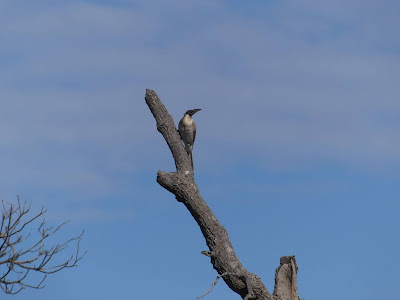BUT, what a day out in that wonderfully pristine environment. The cacophony was contributed to by noisy friarbirds, butcherbirds, spangled drongos, wattlebirds, white-cheeked honeyeaters with a silent pleasure thrown in for good measure.
Yep, another walk in Broadwater National Park, and once more heading south along Hind Dune trail. This is a long post, but I wanted to try and convey the joy of this day with so many birds showing off and sharing their abundant environment. I hope it goes a little way to doing that justice. Certainly a day I will long cherish and such a treat during this prolonged period of covid restrictions.
 |
| Little wattlebird looking to its left |
 |
| Looking to its right too! |
What is a wander in the bush without the dulcet tones of the butcherbird - this is a young grey butcherbird that was perhaps still a few notches shy of dulcet 😉.
This was the first time I had seen more than a couple of spangled drongos in the same location (I mostly sight them as singles). There was quite a large flock - I estimated more than a dozen. It was terrific to be able to get so many clear photos showing off the striking form, the dark (almost foreboding) palette, powerful beak and the gleaming red/orange eyes. Of course, having so many competing in the same spaces meant exposure for me to regular calls. Imagine these mixed with the noisy friarbird and the little wattlebird 😊 ... all quite the harsh contrast to the melodious butcherbird!




Speaking of striking form, the noisy fiarbirds were also numerous and more widespread along the walk. Their orange/red eye is similar to the spangled drongo, though less "glaring" because of a larger black pupil. Occasionally three or four might be seen squabbling, but mostly they perch in pairs or alone as they move swiftly from bush to bush, but always with plenty to say! The little raised bump halfway along their top bill (upper mandible) is a very distinct feature. Check the "noisy" out here (this is a different site to the regular one I have been using as the recording there was not working).





And interspersed with all the friarbird activity, the little wattlebirds kept making appearances. Once again, imagine this call conflicting (they certainly do not "blend" in any harmony and hence my preference to use cacophony!). Three quite different poses are presented below, and I especially enjoyed capturing the third one with the body arched to ensure the head and bill reach skywards for maximum projection of the call.


I know, I know ... more noisy friarbirds 😝 ... but this is about how pervasive they were this day 😀. And they were especially keen to show-off on wide open and bare perches just begging me to photograph them. How could I refuse such settings? Just enjoy them 😋
In case you were thinking that the presence of these bigger agressive birds might have frightened the smaller ones, here are some shots of the ever-present white-cheeked honeyeaters. A distinctive sound also gives their activity away - less harsh than the bigger birds but less melodious than a butcherbird. I also decided to include these to demonstrate the impact of cropping some of the images. I am not a fan of post-editing, preferring to take the photo "as it is" and spend more time "out there" and less in front of the screen (enough already posting to my blog!).
So the next three paired images show the cropped photo first and the orginal second in the pair. Really just mucking about and executing a thought I had while I was selecting the photos to share in the post.
 |
| White-cheeked honeyeater (cropped) |
 |
| Original |
 |
| Same perch looking behind (cropped) |
 |
| Original |
 |
| Noisy friarbird lifting off (cropped) |
 |
| Original |
The next set of photos, also presented in pairs are designed to show you how the features (form and palette and visibility - perhaps camouflage) of a bird can vary as their natural surroundings change. Always beautiful, just sometimes more than others 😊. The star of the exhibition making this point is the white-cheeked honeyeater in older banksias and then banksias with a fresh flush.




And now for that "silent pleasure" I noted at the beginning of the post. I have made much of the noise encountered on this walk. Sometimes, however, it is the silence that catches your attention. Coming around a bend on the return walk things had gone strangely quiet. Only sounds were a slight whistle from the wind and the waves on the beach. A pause, a scan of the surrounds ... ah, a splash of colour in a distant tree ... a PAIR of brahmini kites surveying their domain - good enough reason for some silence from potential prey I reckon! The second photo below shows them both ascending the termals shortly thereafter (and the noise had resumed).
And to finish this wonderful day, what else but a few more photos of the dominant species encountered on this visit. I'm sure you will recognise them - if not, you have not been paying attention (probably just looking at the pictures 😲 (and why not!).
What a wonderful local environment we still have.

































No comments:
Post a Comment